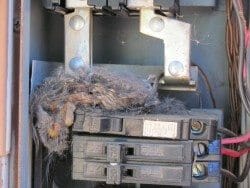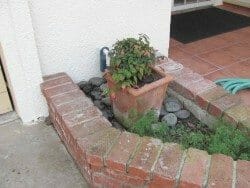The 10 Most Common Electrical Defects That Home Inspectors Find
Home » Inspections »
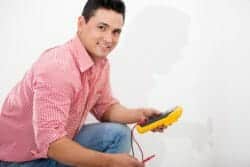
Electrical defects can result in shock, injury and fires. The good news is that most electrical defects can be corrected without spending a fortune.
Some of the defects can be corrected by the home owner, the buyer or a handyman; others should have an electrician correct.
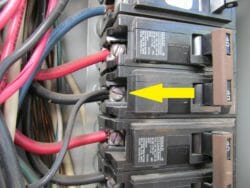
#1 Double Tapping of Circuit Breakers
Double tapping is basically two or more “hot” wires running to one circuit breaker. By “hot’ we are referring to energized wires, ones that can shock you.
The older the home is or the more remodeling that has been done, the more likelihood of this condition existing. This is an issue that an electrician should investigate. Read more
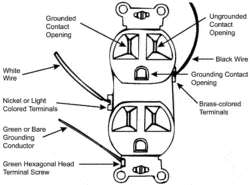
#2 Reversed Polarity
Outlets with reverse polarity cannot be identified by just looking at them. Generally a small electrical tester is used to determine if an outlet has reverse polarity. These testers are usually around $7 to $12 dollars at local home improvement stores.
Most small appliances work, even if an outlet has reverse polarity. However, there can be a safety issue with some lamps or a few appliances. Note that electricians refer to outlets as receptacles. Read more
#3 Ungrounded 3 Prong Plugs (outlets)
Ungrounded outlets are a safety concern and under some circumstances a person can be shocked when using an ungrounded outlet.
Older homes often have ungrounded outlets because only a hot and neutral wire were run to the outlets. The code stared requiring outlets to be grounded around 1965. Some homes built before then have grounded outlets, but many do not. Also, if the outlet was installed by a home owner, then it may not be grounded, even if it was a code requirement at the time. Read more
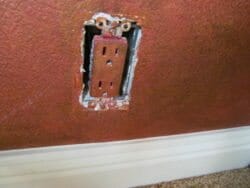
#4 Outlets With Paint On Them
Inspectors generally recommend that any outlet with paint on it be replaced. One reason for this is that if paint (or even drywall mud) has gotten into the slots, then this may cause overheating and a fire.
Also, if the outlet is a tamper resistant type and the paint affects the operation of the tamper-resistant mechanism, then it becomes a safety concern. Replacing painted outlets is wise and inexpensive. Read more
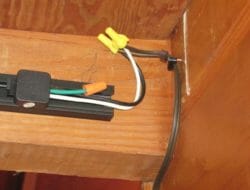
#5 Exposed Wiring and Splices
Exposed wiring or splices are called out by home inspectors for a number of reasons. One, is that exposed wiring is a safety concern in some locations and may be subject to mechanical damage.
Expose splices are likewise a safety concern. Splices that have tape or wire nuts may be installed improperly. If the wire ends become bare and exposed, aching may occur which can cause fires. Having all splices done in an electrical junction box with a cover is much safer. Read more
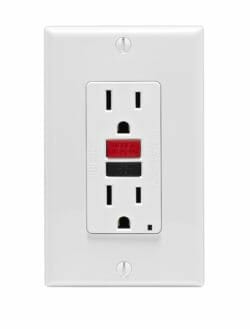
#6 No GFCI protection
GFCI outlets are great safety devices and save many lives from electrical shock. The outlets will trip immediately if a slight imbalance of current is noted. GFCI”s can react as quickly as one-thirtieth of a second, much faster than a standard circuit breaker.
Many homes do not have any or do not have them in the proper locations. GFCI outlets should be in bathrooms, kitchens, exterior areas and garages to name just a few. Read more
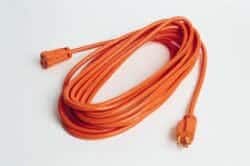
#7 Extension Cords Used For Permanent Power Source
One of the more overlooked issues is the use of extension cords around the home. The fire department can tell you that many house fires and injuries result from extension cords. You would be surprised at the number.
Any device (light, appliance, etc.) that is not temporary should not have an extension cord running to it. This includes the use of an extension cord running to a garage door opener. Another concern is that extension cords often get overloaded, like at Christmas time.
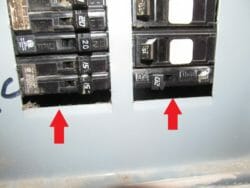
#8 Panel missing knockouts – there are 2 types
Electrical panels have basically two types of knockouts. One is rectangular in shape and the other is round. When you open the door of an electrical panel there may be a slender rectangular piece missing. One where you could stick your finger in; about a ½ inch wide and 2 ½ inches long.
The other type of knock out is a round one. At times these get removed and the electrician forgets to put a round plug in the empty hole. These holes vary from a nickel to a silver dollar in size. Read more
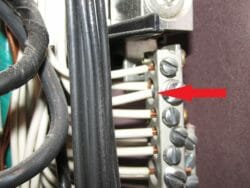
#9 Two Neutrals In One Slot
Inspectors often find two or more neutral wires placed into one slot or hole in the neutral bar of an electrical panel. Generally this does not create a problem, however, if the set screw does not firmly hold the wires tight then over time “connection creep” may occur. Once in a blue moon, one wire may slip out resulting in an open neutral.
It is best to have just one neutral wire per slot, for the chance of coming loose is greatly reduced. Read more
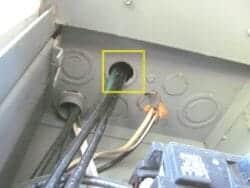
#10 Wiring Against Sharp Metal Edges
Wires that are exposed to sharp metal edges in panels and junction boxes may have damage to the insulation cover of the wire.
There should be a proper bushing or wire clamp holding or protecting the wires from the sharp metal edges.
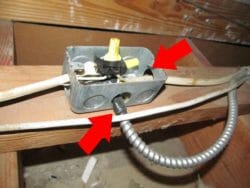
Should proper protection be missing, then a low arch fault may occur where the current jumps from one conductor to another. In example, from the electrical wire to the metal edge of the J-box or electrical panel. Heat results when arching occurs and may result in a house fire. Read more

Bottom Line
Electrical issues can be serious and should not be ignored. A good home inspector will identify most of the defects that should be fixed and an electrician can normally correct the majority of them quickly and inexpensively.

